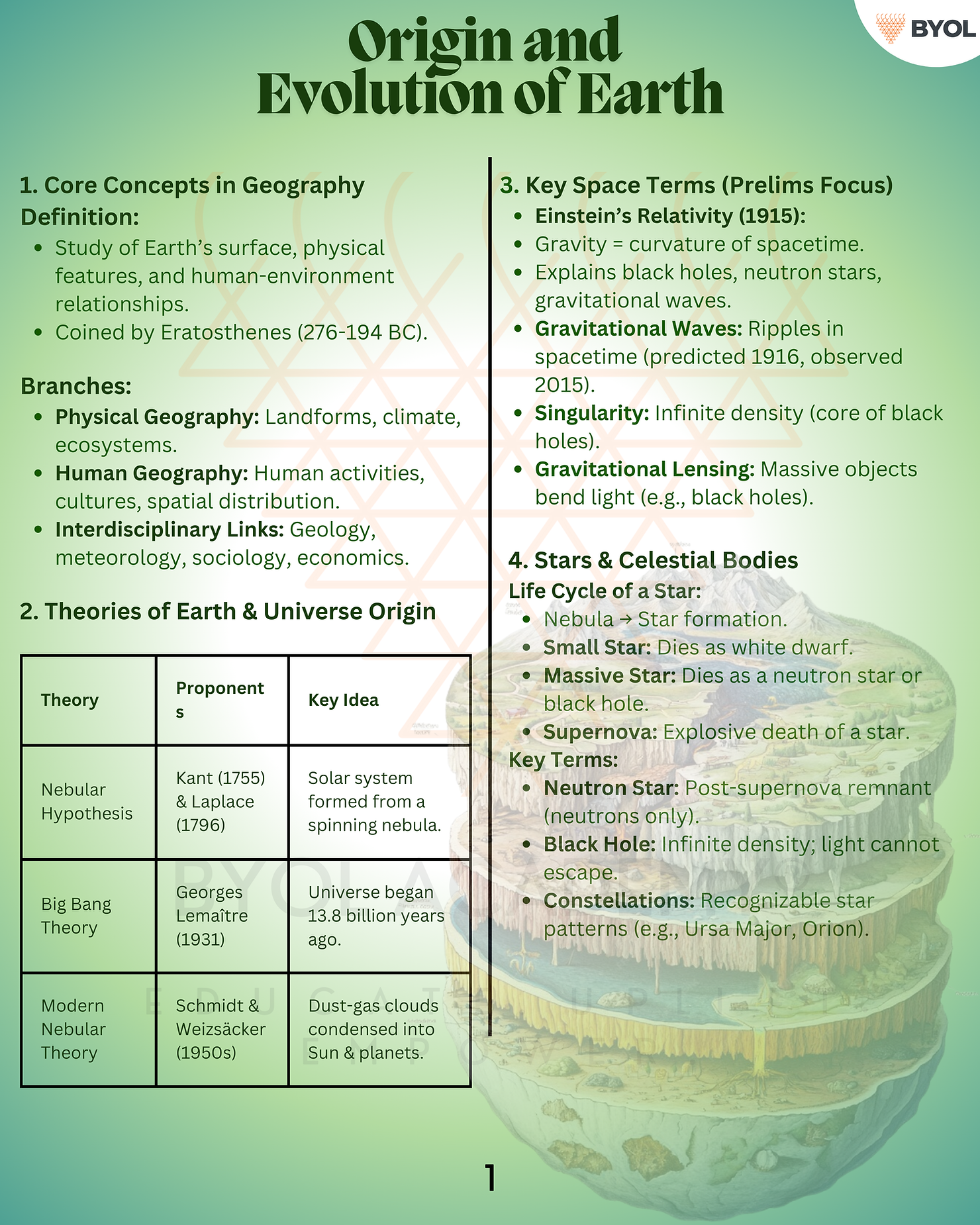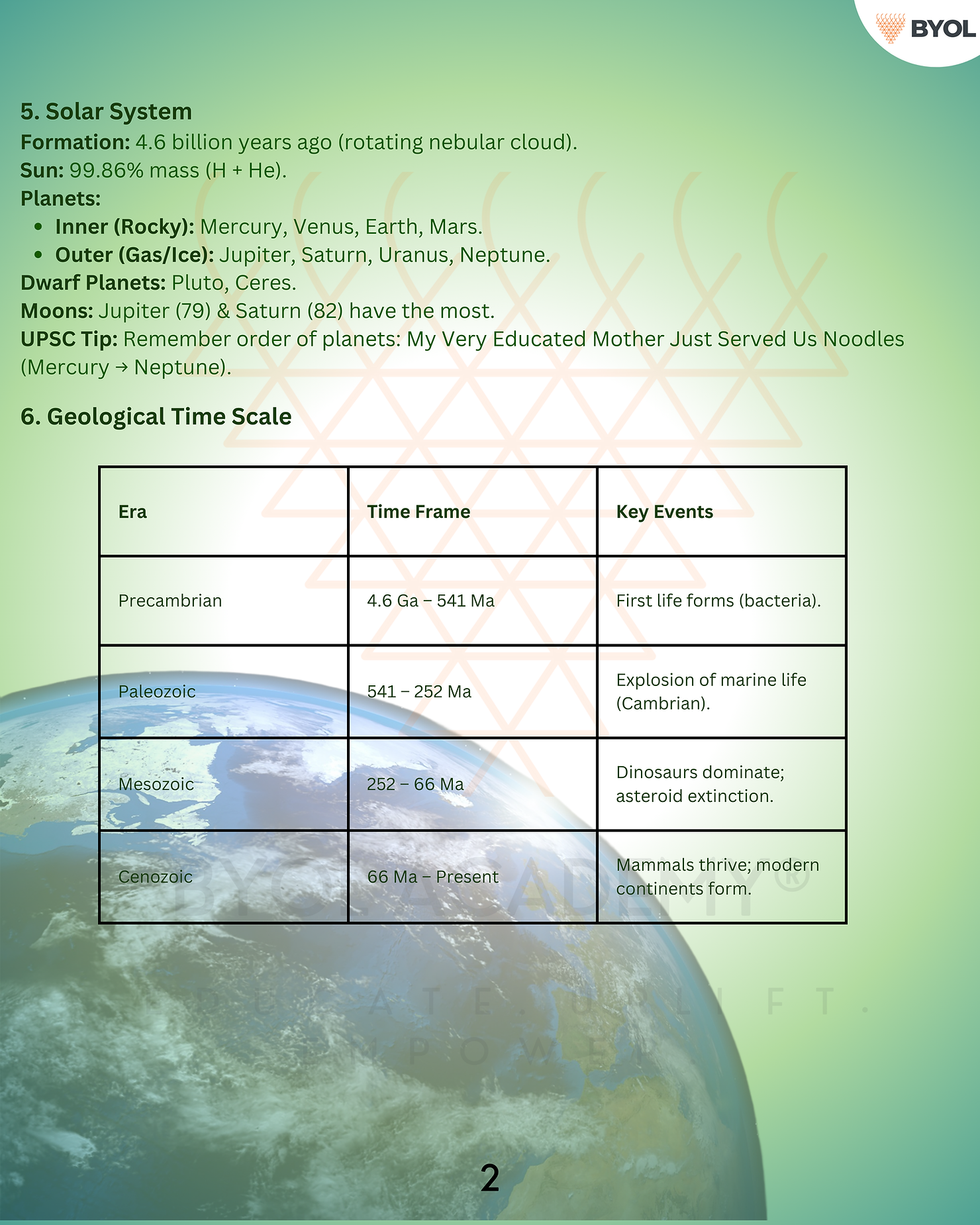Geography as a Discipline
- Definition of Geography: Geography is the study of the Earth’s surface, its physical features, and the relationships between humans and their environment. The term was coined by the Greek scholar Eratosthenes (276-194 BC).
- Branches of Geography:
- Physical Geography: Studies natural features like landforms, climate, and ecosystems.
- Human Geography: Focuses on human activities, cultures, and their spatial distribution.
- Interdisciplinary Nature: Geography overlaps with disciplines like geology, meteorology, sociology, and economics, making it a holistic science.
Theories of Origin of Earth and Universe
- Nebular Hypothesis (Kant-Laplace Hypothesis) – Proposed by Immanuel Kant (1755) & Pierre-Simon Laplace (1796), suggesting that the solar system evolved from a spinning nebula.
- Big Bang Theory (George Lemaitre, 1931) – Universe originated 13.8 billion years ago from a singular explosion.
- Modern Nebular Hypothesis (Otto Schmidt & Carl Weizsäcker, 1950s) – Dust-gas clouds condensed into the Sun and planets.
Some Basic terms about Space(Prelims Specific)
- Einstein’s Theory of Relativity (1915) – The General Theory of Relativity states that gravity is not a force but the curvature of spacetime caused by massive objects. It Helps in understanding black holes, neutron stars, and cosmic events, revolutionizing astrophysics.
- Gravitational Waves (Predicted in 1916) – Ripples in spacetime caused by accelerating massive objects (e.g., merging black holes).
- Gravitational Lensing – Light around a massive object, such as a black hole, is bent, causing it to act as a lens for the things that lie behind it.
- Singularity – A singularity (gravitational singularity or (spacetime singularity) is a condition in which gravity is so intense that spacetime ceases to exist and our laws of physics become invalid. Singularities were first predicted as a result of Einstein’s Theory of General Relativity, which resulted in the theoretical existence of black holes.
- Galaxy-Galaxy is a system of millions or billions of stars, together with gas and dust, held together by gravitational attraction. They are the major building blocks of the universe.
- Life Cycle of a Star- It is formed by a nebula, to its death as a white dwarf(in case of small star) or a neutron star(in case of large star).
- Nebula: A cloud of gas (mostly hydrogen and helium) and dust in space. Nebulae are the birthplaces of stars.
- Supernova – A supernova is the explosive death of a star and often results in the star obtaining the brightness of 100 million suns for a short time
- Neutron star – Neutron stars are composed mainly of neutrons and are produced after a supernova, forcing the protons and electrons to combine to produce a neutron star
- Black Holes – Black holes are believed to form from massive stars at the end of their lifetimes. The density of matter in a black hole cannot be measured (infinite!). The gravitational pull is so great that nothing can escape from it, not even light.
- Constellations – The stars forming a group that has a recognisable shape is called a constellation. A few famous constellations are Great Bear (the Big Dipper or Saptarshi or Ursa Major), Orion (hunter).
Solar System
- The Solar System formed 4.6 billion years ago from a rotating nebular cloud.
- Sun – Making up 99.86% of the Solar System’s mass, primarily hydrogen and helium.
- Planets – Inner (rocky) planets: Mercury, Venus, Earth, Mars; Outer (gas/ice giants): Jupiter, Saturn, Uranus, Neptune.
- Dwarf Planets & Moons – Pluto, Ceres, and others; Jupiter and Saturn have the most moons. Mnemonics to remember order of planets: “My Very Educated Mother Just Served Us Noodles” (Mercury → Neptune).
Geological Time Scale (For Prelims)
- Precambrian (4.6 billion – 541 million years ago) – Earth’s early history, first life forms.
- Paleozoic Era (541-252 million years ago) – Explosion of marine life.
- Mesozoic Era (252-66 million years ago) – Dinosaurs dominated; ended with asteroid impact.
- Cenozoic Era (66 million years ago – Present) – Mammals evolved, modern continents formed.







